Canned Beans Market
Canned Beans Market Size and Share Forecast Outlook 2025 to 2035
Canned beans market is projected to grow from USD 7.2 billion in 2025 to USD 9.4 billion by 2035, at a CAGR of 2.7%. Baked/Seasoned will dominate with a 45.0% market share, while kidney/red will lead the bean type segment with a 35.0% share.
Canned Beans Market Forecast and Outlook 2025 to 2035
The canned beans market stands positioned for measured growth over the next decade, advancing from USD 7,200.0 million in 2025 to USD 9,400.0 million by 2035. This trajectory reflects steady consumer adoption of convenient protein sources and the expanding role of ready-to-eat legumes across global food systems, the market will rise at a CAGR of 2.7% which particularly in retail channels and commercial food service operations.
The first half of the forecast period (2025-2030) will see market value climb from USD 7,200.0 million to approximately USD 8,230.0 million, representing an addition of USD 1,030.0 million or 44% of the total decade growth. This phase features continued expansion of retail distribution networks, driven by urbanization patterns and changing dietary preferences toward plant-based protein sources. Processing technology improvements and supply chain optimization will become standard industry practices rather than competitive advantages.
Quick Stats for Canned Beans Market
- Canned Beans Market Value (2025): USD 7,200.0 million
- Canned Beans Market Forecast Value (2035): USD 9,400.0 million
- Canned Beans Market Forecast CAGR: 2.7%
- Leading Type in Canned Beans Market: Baked/Seasoned Segment
- Key Growth Regions in Canned Beans Market: North America, South Asia Pacific, and East Asia
- Top Players in Canned Beans Market: Bush Brothers, Heinz, Bonduelle, Goya Foods, Hain Celestial
- Where revenue comes from - now vs next (industry-level view)
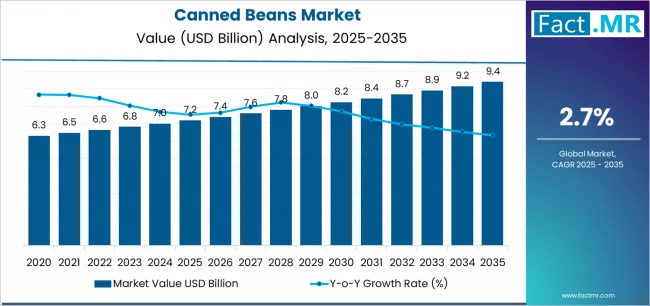
The latter half (2030-2035) will witness continued advancement from USD 8,230.0 million to USD 9,400.0 million, adding USD 1,170.0 million or 56% of the period's total expansion. This stage will be characterized by market maturation in developed regions, continued penetration in emerging economies, and growing integration with health-conscious consumer segments. The market progression signals fundamental shifts in how consumers and food service operators approach protein procurement and meal preparation convenience.
Canned bean production encompasses sophisticated processing operations coordinating variety-specific preparation methods, quality preservation systems, and packaging technologies across diverse bean types including kidney beans, chickpeas, pinto beans, and specialty varieties. Processing facilities utilize steam cooking, precise temperature control, and flavor preservation techniques to maintain nutritional profiles while achieving shelf stability requirements. Modern canning operations integrate quality control systems, automated filling processes, and packaging innovations that preserve product integrity throughout extended distribution chains.
Retail applications drive primary market demand through consumer preferences for convenient protein sources, quick meal preparation options, and pantry staples that support varied cooking applications. Baked and seasoned varieties provide ready-to-eat solutions for time-conscious consumers, while plain varieties offer culinary flexibility for home cooking and recipe integration. Specialty and organic segments appeal to health-focused consumers seeking premium ingredients and clean-label formulations.
Food service channels encompass commercial kitchen operations, restaurant chains, and institutional feeding programs requiring consistent supply, standardized specifications, and cost-effective protein solutions. Bulk packaging formats support high-volume preparation while maintaining portion control and inventory management efficiency. Processing standardization ensures uniform cooking characteristics and flavor profiles across different preparation methods and service contexts.
Evolving consumer trends toward plant-based diets, flexitarian lifestyles, and sustainable protein consumption are expected to reinforce demand for canned beans. Innovations in fortification, such as added vitamins, minerals, and fiber, are emerging to appeal to health-conscious segments seeking functional benefits beyond basic nutrition. Regional taste preferences are influencing product differentiation, with spiced, flavored, and ethnic varieties gaining traction in both retail and food service sectors. E-commerce and direct-to-consumer distribution channels are expanding accessibility, enabling smaller brands to reach niche audiences. Sustainability initiatives, including recyclable packaging and reduced water usage during processing, further enhance market appeal and long-term growth potential.
| Period | Primary Revenue Buckets | Share | Notes |
|---|---|---|---|
| Today | Baked/Seasoned varieties | 45% | Convenience-driven, flavor focus |
| Plain varieties | 35% | Cooking flexibility, ingredient base | |
| Specialty/Organic varieties | 20% | Premium positioning, health focus | |
| Kidney/Red beans | 35% | Primary variety type | |
| Chickpea varieties | 25% | Growing protein demand | |
| Pinto beans | 20% | Regional preferences | |
| Other varieties | 20% | Specialty applications | |
| Future (3-5 yrs) | Enhanced baked systems | 42-48% | Flavor innovation, convenience gains |
| Expanded plain solutions | 33-38% | Recipe integration, cooking flexibility | |
| Premium specialty products | 18-25% | Health positioning, organic growth | |
| Diversified kidney products | 32-38% | Product line extension | |
| Advanced chickpea systems | 26-30% | Protein trend alignment | |
| Optimized pinto platforms | 18-22% | Regional expansion | |
| Specialty variety growth | 18-24% | Market diversification |
Canned Beans Market Key Takeaways
At-a-Glance Metrics
| Metric | Value |
|---|---|
| Market Value (2025) → | USD 7,200.0 million |
| Market Forecast (2035) ↑ | USD 9,400.0 million |
| Growth Rate ★ | 2.7% CAGR |
| Leading Type → | Baked/Seasoned Segment |
| Primary Channel → | Retail Channel |
The market demonstrates stable fundamentals with baked and seasoned varieties capturing dominant position through convenience capabilities and flavor enhancement. Retail channels drive primary distribution, supported by increasing consumer preference for quick meal solutions and pantry convenience.
Geographic expansion remains concentrated in developed markets with established distribution infrastructure, while emerging economies show accelerating adoption rates driven by urbanization initiatives and changing dietary patterns.
Imperatives for Stakeholders in Canned Beans Market
Design for meal versatility, not just protein content
- Offer complete meal solutions: canned beans + recipe integration + nutritional information + preparation guidance + serving suggestions
- Preconfigured cooking workflows: preparation methods, seasoning combinations, cooking integration, and meal planning applications
Technology readiness for Food 4.0
- Real-time inventory management analytics, supply chain optimization capabilities, and smart retail integration (barcode connectivity, stock tracking systems)
Health-by-design approach
- Clean label formulations, nutritional transparency, certified processing methods, and paperless ingredient documentation
Value-based retail models
- Clear base product pricing + transparent quality tiers (organic options, specialty varieties, premium packaging); subscription services for bulk purchasing and regular delivery
Segmental Analysis
The market segments by type into baked/seasoned (45%), plain (35%), and specialty/organic (20%) varieties, illustrating the shift from basic protein offerings to comprehensive meal solutions and health-focused options.
The bean type segmentation further divides the market into kidney/red (35%), chickpea (25%), pinto (20%), and other varieties (20%), highlighting differences in consumer preferences, regional tastes, and culinary uses.
Distribution channels include retail (80%), food service (15%), and institutional (5%), reflecting varied market access needs and operational efficiency requirements. The segmentation indicates a progression from standard protein sources toward specialized culinary applications, with a focus on convenience, health, and diverse supply chain strategies.
By Type, the Baked/Seasoned Segment Accounts for Dominant Market Share
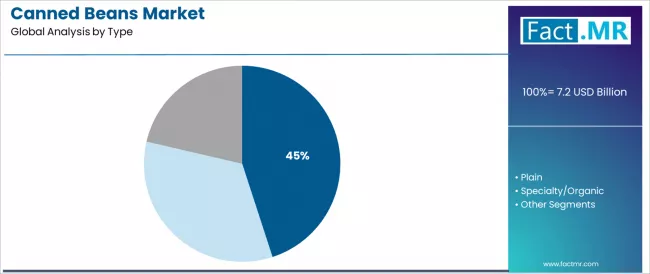
Baked and seasoned varieties hold the leading position in the canned beans market, capturing 45% of the market due to their convenience features, such as ready-to-eat functionality, flavor enhancement, and ease of meal preparation that allow consumers to create quick and versatile dishes. This segment thrives on consumer demand for convenient meal components that deliver consistent taste, reduce cooking complexity, and save time without the need for major recipe adjustments.
Enhanced formulation features support portion control, flavor uniformity, and seamless integration into meal planning, making convenience and taste key drivers. Baked and seasoned beans stand out by offering reliable meal integration, consistent flavor quality, and compatibility with fast-cooking systems, ensuring effective and enjoyable culinary experiences across a range of applications.
Key market characteristics:
- Advanced seasoning formulations with optimized flavor configuration and taste consistency capabilities
- Enhanced meal integration effectiveness, enabling 90-95% preparation time reduction with reliable flavor performance
- Kitchen compatibility, including microwave heating systems, stovetop integration, and serving optimization for meal control
Plain Varieties Show Cooking Flexibility Growth
Plain varieties maintain a 35% market position in the canned beans market due to their culinary versatility properties and ingredient flexibility characteristics. These products appeal to consumers requiring cooking adaptability with premium positioning for recipe integration and meal customization applications. Market growth is driven by cooking segment expansion, emphasizing flexible meal solutions and preparation efficiency through optimized ingredient designs.
Specialty/Organic Varieties Demonstrate Premium Positioning
Specialty and organic varieties capture 20% market share through health-conscious requirements in clean label applications, organic certification, and premium positioning applications. These operations demand certified processing systems capable of maintaining organic standards while providing effective nutritional benefits and quality assurance capabilities.
By Bean Type, Kidney/Red Varieties Show Market Leadership
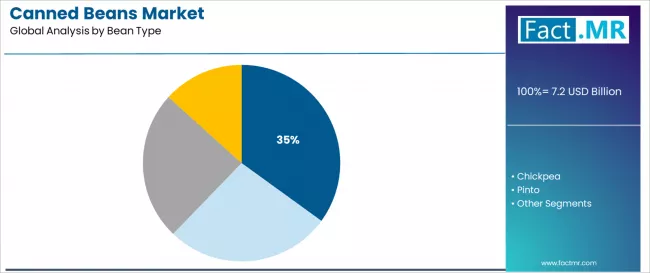
Kidney and red bean varieties lead the canned beans market with a 35% share, driven by their versatility, adaptability in recipes, and ability to support diverse culinary applications while maintaining nutritional value. Consumers value these beans for their flexibility in cooking, high nutritional content, and seamless integration into existing recipes, allowing coordinated meal preparation across various dishes.
The segment benefits from strong consumer familiarity and widespread use in cooking programs that emphasize kidney beans for recipe optimization and efficient meal planning. Growth is further fueled by the inclusion of kidney varieties in standard cooking ingredients and rising demand for convenient, nutritionally compliant, and easy-to-prepare meal solutions.
Chickpea Varieties Maintain Protein Focus
Chickpea varieties capture 25% market share through comprehensive protein requirements in health-conscious applications, Mediterranean cuisine, and plant-based dietary applications requiring reliable protein sources capable of operating within diverse recipes while providing effective nutritional integration and cooking performance capabilities.
Pinto Varieties Show Regional Preference
Pinto varieties account for 20% market share, including regional cuisine applications, Mexican food preparation, and cultural cooking applications requiring traditional ingredients for meal optimization and recipe authenticity.
Other Varieties Demonstrate Specialty Applications
Other bean varieties account for 20% market share, including specialty cuisines, gourmet applications, and niche cooking requirements for culinary optimization and recipe diversification.
By Channel, Retail Distribution Shows Market Leadership
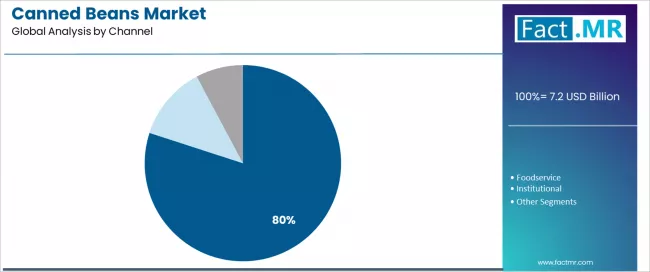
Retail distribution dominates the canned beans market, capturing an 80% share, driven by widespread adoption of consumer purchasing channels and a focus on accessibility, convenience, and consistent product availability. Shoppers value ease of access, reliable stock, and seamless integration with existing grocery systems, supporting efficient household purchasing across multiple trips.
The segment benefits from significant investment in distribution networks and retail programs that ensure a wide range of canned bean options for meal planning and household needs. Market growth is supported by retail expansion initiatives that position canned beans as staple grocery items and rising household demand for convenient, ready-to-use protein sources that simplify shopping and meal preparation.
Application dynamics include:
- Strong growth in household purchasing and cooking operations requiring accessible protein capabilities
- Increasing adoption in meal planning optimization and cooking convenience applications for consumers
- Rising integration with grocery shopping systems for purchase optimization and inventory management
Food Service Distribution Maintains Commercial Demand
Food service distribution captures 15% market share through comprehensive supply requirements in restaurant operations, commercial kitchens, and food service applications. These operations demand reliable supply systems capable of handling commercial volumes while providing effective inventory management and operational performance capabilities.
Institutional Distribution Shows Specialized Growth
Institutional distribution accounts for 5% market share, including school feeding programs, healthcare food service, and institutional applications requiring bulk supply solutions for operational optimization and cost management.
What are the Drivers, Restraints, and Key Trends of the Canned Beans Market?
| Category | Factor | Impact | Why It Matters |
|---|---|---|---|
| Driver | Health awareness growth & protein demand (plant-based nutrition, dietary requirements) | ★★★★★ | Large-scale health markets require accessible, affordable protein solutions with consistent nutritional profiles and dietary compliance across cooking applications |
| Driver | Convenience cooking adoption & meal preparation (time efficiency, cooking simplicity) | ★★★★★ | Drives demand for ready-to-use ingredients and quick meal solutions; suppliers providing convenient formats gain competitive advantage |
| Driver | Retail expansion & accessibility (distribution networks, availability) | ★★★★☆ | Consumer markets need accessible food options; demand for convenient formats expanding addressable market segments |
| Restraint | Fresh alternatives competition & cooking preferences (preparation methods, ingredient selection) | ★★★★☆ | Cooking-focused consumers face choices with ingredient selection and preparation requirements, limiting adoption in fresh-focused segments |
| Restraint | Price sensitivity & economic factors (cost considerations, budget constraints) | ★★★☆☆ | Cost-focused applications face challenges with premium positioning and pricing requirements, limiting adoption in price-sensitive segments |
| Trend | Organic product adoption & clean labeling (natural ingredients, processing transparency) | ★★★★★ | Growing demand for clean ingredient solutions; organic positioning becomes core value proposition in health-conscious segments |
| Trend | International cuisine growth & flavor diversification (ethnic foods, recipe integration) | ★★★★☆ | Culinary expansion drives demand for diverse bean varieties; flavor innovation capabilities drive competition toward specialization |
Analysis of the Canned Beans Market by Key Country
The canned beans market exhibits diverse regional dynamics, with growth leaders such as India (3.6% CAGR) and China (3.2% CAGR) expanding through urbanization and dietary modernization initiatives. Steady performers include Brazil (3.0% CAGR), Mexico (2.7% CAGR), and the USA (2.5% CAGR), supported by established consumption habits and robust distribution networks.
Mature markets like Australia (2.7% CAGR) and the UK (2.4% CAGR) sustain growth through convenience-driven consumption and rising health awareness. Overall, South and East Asian markets lead adoption via urban expansion and dietary diversification, Western markets maintain steady growth through convenience and health trends, and emerging markets experience accelerated growth fueled by urbanization and modernized food consumption patterns.
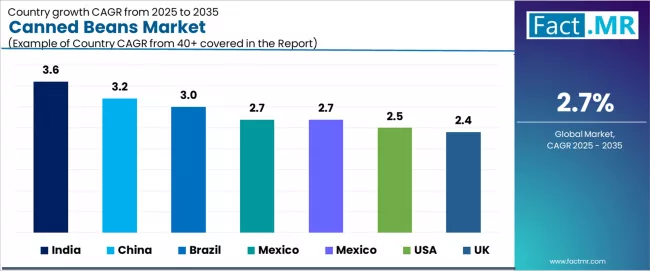
| Region/Country | 2025-2035 Growth | How to win | What to watch out |
|---|---|---|---|
| India | 3.6% | Focus on affordable protein solutions | Infrastructure challenges; distribution complexity |
| China | 3.2% | Lead with convenient cooking systems | Dietary preferences; local competition |
| Brazil | 3.0% | Provide culturally appropriate varieties | Economic volatility; import regulations |
| Mexico | 2.7% | Offer traditional recipe integration | Regional preferences; local production |
| USA | 2.5% | Premium convenience positioning | Market saturation; health regulations |
| Australia | 2.7% | Push health-focused applications | Market maturity; competition intensity |
| UK | 2.4% | Premium quality positioning | Brexit impacts; supply chain complexity |
India Drives Fastest Market Growth
India establishes fastest market growth through aggressive urbanization programs and comprehensive dietary modernization, integrating canned beans as accessible protein sources in urban households and commercial food operations. The country's 3.6% growth rate reflects economic development initiatives promoting convenient food options and protein accessibility that support urban lifestyle adoption. Growth concentrates in major urban centers, including Delhi, Mumbai, and Bangalore, where food retail development showcases modern distribution systems that appeal to consumers seeking convenient protein solutions and cooking efficiency applications.
Indian distributors are developing cost-effective protein solutions that combine local affordability with proven nutritional features, including accessible pricing systems and enhanced distribution capabilities. Supply channels through grocery retailers and urban food distributors expand market access, while economic development supports adoption across diverse consumer segments.
Strategic Market Indicators:
- Urban households leading adoption with 58% deployment rate in convenient cooking systems and protein sectors
- Economic development programs providing support for food distribution infrastructure development
- Local retailers capturing 42% market share through competitive pricing and localized distribution support
- Market development for affordable protein solutions targeting urban consumer markets
China Emerges as Convenience-Focused Market
In Guangdong, Jiangsu, and Shanghai provinces, urban households and food service operations are implementing canned beans as standard ingredients for meal preparation and commercial food operations, driven by increasing urbanization investment and dietary modernization programs that emphasize convenient cooking solutions. The market holds a 3.2% growth rate, supported by urban development initiatives and food modernization programs that promote accessible protein sources for urban applications.
Chinese consumers are adopting convenient food systems that provide consistent preparation performance and nutritional benefits, appealing in urban regions where cooking efficiency and food convenience represent critical lifestyle requirements. Market expansion benefits from growing food retail capabilities and urban integration that enable domestic distribution of convenient food systems for urban applications.
USA Shows Premium Market Development
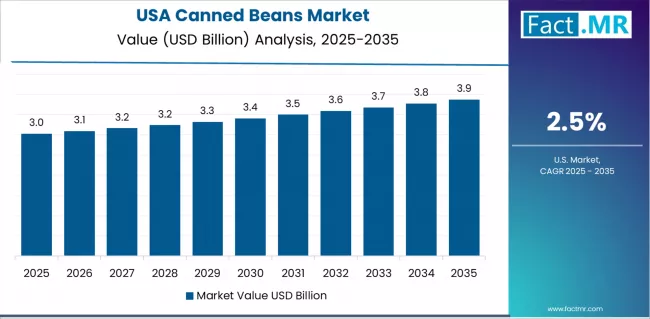
USA establishes premium market development through established retail programs and developed distribution infrastructure, integrating canned beans across household applications and food service operations. The country's 2.5% growth rate reflects mature market relationships and established consumption patterns that support widespread use of convenient protein sources in cooking applications and food preparation operations. Growth concentrates in major retail centers, including California, Texas, and Florida, where food retail showcases mature distribution systems that appeal to consumers seeking proven convenience capabilities and cooking efficiency applications.
American retailers leverage established distribution networks and comprehensive brand capabilities, including marketing programs and product variety that create consumer relationships and operational advantages. The market benefits from mature retail standards and consumer preferences that support convenient food system use while supporting product innovation and brand optimization.
Brazil Demonstrates Regional Cuisine Focus
Brazil establishes regional cuisine focus through traditional cooking programs and cultural food infrastructure, integrating canned beans across household facilities and traditional cooking applications. The country's 3.0% growth rate reflects growing consumer income and established cultural adoption that supports widespread use of bean-based ingredients in traditional cooking and household food preparation. Growth concentrates in major urban areas, including São Paulo, Rio de Janeiro, and Belo Horizonte, where food retail showcases traditional ingredient systems that appeal to consumers seeking cultural food solutions with modern convenience compatibility.
Brazilian retailers focus on maintaining cultural standards while adopting convenient food efficiency, creating demand for systems that balance tradition with operational advantages. The market benefits from strong cultural infrastructure and growing urban opportunities that support convenient food adoption while maintaining cultural standards important to Brazilian cooking applications.
Mexico Shows Traditional Application Development
Mexico establishes traditional application development through comprehensive cultural food modernization and cuisine integration, integrating canned beans across household facilities and traditional cooking applications. The country's 2.7% growth rate reflects growing urban investment and increasing adoption of convenient food systems that support expanding use of traditional ingredients in Mexican households. Growth concentrates in major urban areas, including Mexico City, Guadalajara, and Monterrey, where food retail development showcases integrated traditional systems that appeal to Mexican consumers seeking cultural food solutions with convenience compatibility.
Mexican retailers focus on maintaining cultural standards while adopting convenient food efficiency, creating demand for systems that balance tradition with operational advantages. The market benefits from strong cultural infrastructure and growing urban opportunities that support convenient food adoption while maintaining cultural standards important to Mexican cooking applications.
Australia Shows Health-Focused Development
Australia establishes health-focused development through comprehensive wellness programs and nutrition-oriented food infrastructure, integrating canned beans across household facilities and health-conscious applications. The country's 2.7% growth rate reflects growing health awareness and established nutrition adoption that supports widespread use of protein sources in health applications and dietary planning operations. Growth concentrates in major urban centers, including Sydney, Melbourne, and Brisbane, where food retail showcases health-oriented systems that appeal to consumers seeking nutrition solutions with convenience compatibility.
Australian retailers focus on maintaining health standards while adopting convenient nutrition efficiency, creating demand for systems that balance health with operational advantages. The market benefits from strong health infrastructure and growing wellness opportunities that support convenient nutrition adoption while maintaining health standards important to Australian dietary applications.
UK Shows Premium Quality Development
The UK establishes premium quality development through established retail programs and quality-focused food infrastructure, integrating canned beans across household facilities and premium cooking applications.
The country's 2.4% growth rate reflects growing retail sophistication and established quality adoption that supports widespread use of premium ingredients in cooking applications and meal preparation operations. Growth concentrates in major retail centers, including London, Manchester, and Birmingham, where food retail showcases quality-oriented systems that appeal to consumers seeking premium food solutions with convenience compatibility.
British retailers focus on maintaining quality standards while adopting convenient food efficiency, creating demand for systems that balance quality with operational advantages. The market benefits from strong quality infrastructure and established retail opportunities that support convenient food adoption while maintaining quality standards important to British cooking applications.
Europe Market Split by Country
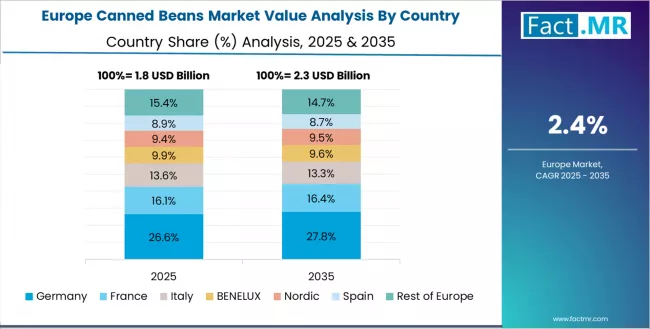
The canned beans market in Europe is set to account for a substantial share of global consumption, with widespread distribution across key economies. Germany is projected to lead with USD 1,300.0 million in 2025, supported by advanced retail networks and major urban centers. The UK follows at USD 980.0 million, driven by extensive retail programs and the growth of convenience-focused food products.
France is expected to reach USD 760.0 million, bolstered by specialized culinary applications and strict food compliance standards. Italy and Spain are forecasted at USD 580.0 million and USD 460.0 million, respectively, while the rest of Europe totals USD 1,120.0 million, reflecting rising adoption of convenient foods in Nordic countries and the expansion of modern retail facilities.
Competitive Landscape of the Canned Beans Market
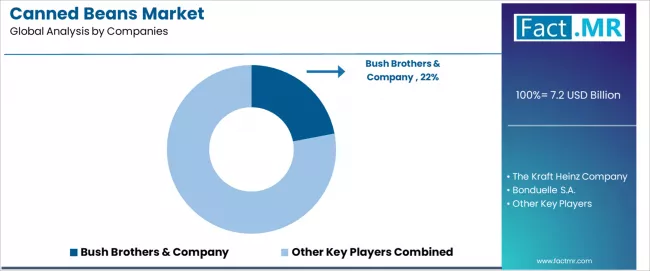
- Structure: 15-20 active players; top 3-4 hold 40-45% by revenue, with Bush Brothers leading at 14.0% market share
- Leadership is maintained through: global distribution networks, brand recognition systems, and product variety capabilities (multi-variety offerings + quality consistency + retail partnerships)
- What's commoditizing: standard plain varieties and basic packaging systems
- Margin Opportunities: premium organic products, specialty flavoring, and comprehensive meal solutions (recipe integration, nutritional positioning, convenience packaging)
| Stakeholder | What they actually control | Typical strengths | Typical blind spots |
|---|---|---|---|
| Global platforms | Distribution networks, broad product portfolios, manufacturing facilities | Proven reliability, multi-region support, comprehensive variety | Technology refresh cycles; consumer trend dependency |
| Regional specialists | Local sourcing, cultural preferences, nearby distribution support | "Close to market" support; cultural pricing; local tastes | Scaling limitations; brand recognition gaps |
| Premium brands | Quality positioning, organic certification, specialized formulations | Premium market access; health positioning; quality assurance | Cost sensitivity markets; volume scaling |
| Private label | Retail partnerships, cost efficiency, volume production | Price competitiveness; retail integration; supply consistency | Brand differentiation; innovation limitations |
Key Players in the Canned Beans Market
- Bush Brothers & Company
- The Kraft Heinz Company
- Bonduelle S.A.
- Goya Foods, Inc.
- The Hain Celestial Group, Inc.
- B&G Foods, Inc.
- Campbell Soup Company
- Princes Limited
- Del Monte Foods, Inc.
- Hormel Foods Corporation
- Green Giant (brand of B&G Foods, Inc.)
- Ardo NV
- Franco Foods
- Ligo Enterprises, Inc.
Scope of the Report
| Items | Values |
|---|---|
| Quantitative Units (2025) | USD 7,200.0 million |
| Type | Baked/Seasoned, Plain, Specialty/Organic |
| Bean Type | Kidney/Red, Chickpea, Pinto, Others |
| Channel | Retail, Foodservice, Institutional |
| Regions Covered | East Asia, Western Europe, South Asia Pacific, North America, Latin America, Middle East & Africa |
| Countries Covered | China, Germany, United States, Japan, India, South Korea, Brazil, France, United Kingdom, Mexico, and 25+ additional countries |
| Key Companies Profiled | Bush Brothers, Heinz, Bonduelle, Goya Foods, Hain Celestial, B&G Foods, Campbell Soup, Princes Foods, Del Monte, HORMEL |
| Additional Attributes | Dollar sales by type and bean type categories, regional adoption trends across East Asia, Western Europe, and South Asia Pacific, competitive landscape with food manufacturers and retail providers, consumer preferences for convenience consistency and nutritional reliability, integration with retail platforms and inventory monitoring systems. |
Canned Beans Market by Segments
-
Type:
- Baked/Seasoned
- Plain
- Specialty/Organic
-
Bean Type:
- Kidney/Red
- Chickpea
- Pinto
- Others
-
Channel:
- Retail
- Foodservice
- Institutional
-
Region:
- East Asia
- China
- Japan
- South Korea
- South Asia Pacific
- India
- ASEAN
- Australia & New Zealand
- Rest of South Asia Pacific
- Western Europe
- Germany
- France
- United Kingdom
- Italy
- Spain
- Rest of Western Europe
- North America
- United States
- Canada
- Mexico
- Latin America
- Brazil
- Rest of Latin America
- Middle East & Africa
- GCC Countries
- South Africa
- Rest of Middle East & Africa
- East Asia
Table of Content
- Executive Summary
- Global Market Outlook
- Demand to side Trends
- Supply to side Trends
- Technology Roadmap Analysis
- Analysis and Recommendations
- Market Overview
- Market Coverage / Taxonomy
- Market Definition / Scope / Limitations
- Market Background
- Market Dynamics
- Drivers
- Restraints
- Opportunity
- Trends
- Scenario Forecast
- Demand in Optimistic Scenario
- Demand in Likely Scenario
- Demand in Conservative Scenario
- Opportunity Map Analysis
- Product Life Cycle Analysis
- Supply Chain Analysis
- Investment Feasibility Matrix
- Value Chain Analysis
- PESTLE and Porter’s Analysis
- Regulatory Landscape
- Regional Parent Market Outlook
- Production and Consumption Statistics
- Import and Export Statistics
- Market Dynamics
- Global Market Analysis 2020 to 2024 and Forecast, 2025 to 2035
- Historical Market Size Value (USD Million) Analysis, 2020 to 2024
- Current and Future Market Size Value (USD Million) Projections, 2025 to 2035
- Y to o to Y Growth Trend Analysis
- Absolute $ Opportunity Analysis
- Global Market Pricing Analysis 2020 to 2024 and Forecast 2025 to 2035
- Global Market Analysis 2020 to 2024 and Forecast 2025 to 2035, By Type
- Introduction / Key Findings
- Historical Market Size Value (USD Million) Analysis By Type , 2020 to 2024
- Current and Future Market Size Value (USD Million) Analysis and Forecast By Type , 2025 to 2035
- Baked/Seasoned
- Plain
- Specialty/Organic
- Y to o to Y Growth Trend Analysis By Type , 2020 to 2024
- Absolute $ Opportunity Analysis By Type , 2025 to 2035
- Global Market Analysis 2020 to 2024 and Forecast 2025 to 2035, By Bean Type
- Introduction / Key Findings
- Historical Market Size Value (USD Million) Analysis By Bean Type, 2020 to 2024
- Current and Future Market Size Value (USD Million) Analysis and Forecast By Bean Type, 2025 to 2035
- Kidney/Red
- Chickpea
- Pinto
- Others
- Y to o to Y Growth Trend Analysis By Bean Type, 2020 to 2024
- Absolute $ Opportunity Analysis By Bean Type, 2025 to 2035
- Global Market Analysis 2020 to 2024 and Forecast 2025 to 2035, By Channel
- Introduction / Key Findings
- Historical Market Size Value (USD Million) Analysis By Channel, 2020 to 2024
- Current and Future Market Size Value (USD Million) Analysis and Forecast By Channel, 2025 to 2035
- Retail
- Foodservice
- Institutional
- Y to o to Y Growth Trend Analysis By Channel, 2020 to 2024
- Absolute $ Opportunity Analysis By Channel, 2025 to 2035
- Global Market Analysis 2020 to 2024 and Forecast 2025 to 2035, By Region
- Introduction
- Historical Market Size Value (USD Million) Analysis By Region, 2020 to 2024
- Current Market Size Value (USD Million) Analysis and Forecast By Region, 2025 to 2035
- North America
- Latin America
- Western Europe
- Eastern Europe
- East Asia
- South Asia and Pacific
- Middle East & Africa
- Market Attractiveness Analysis By Region
- North America Market Analysis 2020 to 2024 and Forecast 2025 to 2035, By Country
- Historical Market Size Value (USD Million) Trend Analysis By Market Taxonomy, 2020 to 2024
- Market Size Value (USD Million) Forecast By Market Taxonomy, 2025 to 2035
- By Country
- USA
- Canada
- Mexico
- By Type
- By Bean Type
- By Channel
- By Country
- Market Attractiveness Analysis
- By Country
- By Type
- By Bean Type
- By Channel
- Key Takeaways
- Latin America Market Analysis 2020 to 2024 and Forecast 2025 to 2035, By Country
- Historical Market Size Value (USD Million) Trend Analysis By Market Taxonomy, 2020 to 2024
- Market Size Value (USD Million) Forecast By Market Taxonomy, 2025 to 2035
- By Country
- Brazil
- Chile
- Rest of Latin America
- By Type
- By Bean Type
- By Channel
- By Country
- Market Attractiveness Analysis
- By Country
- By Type
- By Bean Type
- By Channel
- Key Takeaways
- Western Europe Market Analysis 2020 to 2024 and Forecast 2025 to 2035, By Country
- Historical Market Size Value (USD Million) Trend Analysis By Market Taxonomy, 2020 to 2024
- Market Size Value (USD Million) Forecast By Market Taxonomy, 2025 to 2035
- By Country
- Germany
- UK
- Italy
- Spain
- France
- Nordic
- BENELUX
- Rest of Western Europe
- By Type
- By Bean Type
- By Channel
- By Country
- Market Attractiveness Analysis
- By Country
- By Type
- By Bean Type
- By Channel
- Key Takeaways
- Eastern Europe Market Analysis 2020 to 2024 and Forecast 2025 to 2035, By Country
- Historical Market Size Value (USD Million) Trend Analysis By Market Taxonomy, 2020 to 2024
- Market Size Value (USD Million) Forecast By Market Taxonomy, 2025 to 2035
- By Country
- Russia
- Poland
- Hungary
- Balkan & Baltic
- Rest of Eastern Europe
- By Type
- By Bean Type
- By Channel
- By Country
- Market Attractiveness Analysis
- By Country
- By Type
- By Bean Type
- By Channel
- Key Takeaways
- East Asia Market Analysis 2020 to 2024 and Forecast 2025 to 2035, By Country
- Historical Market Size Value (USD Million) Trend Analysis By Market Taxonomy, 2020 to 2024
- Market Size Value (USD Million) Forecast By Market Taxonomy, 2025 to 2035
- By Country
- China
- Japan
- South Korea
- By Type
- By Bean Type
- By Channel
- By Country
- Market Attractiveness Analysis
- By Country
- By Type
- By Bean Type
- By Channel
- Key Takeaways
- South Asia and Pacific Market Analysis 2020 to 2024 and Forecast 2025 to 2035, By Country
- Historical Market Size Value (USD Million) Trend Analysis By Market Taxonomy, 2020 to 2024
- Market Size Value (USD Million) Forecast By Market Taxonomy, 2025 to 2035
- By Country
- India
- ASEAN
- Australia & New Zealand
- Rest of South Asia and Pacific
- By Type
- By Bean Type
- By Channel
- By Country
- Market Attractiveness Analysis
- By Country
- By Type
- By Bean Type
- By Channel
- Key Takeaways
- Middle East & Africa Market Analysis 2020 to 2024 and Forecast 2025 to 2035, By Country
- Historical Market Size Value (USD Million) Trend Analysis By Market Taxonomy, 2020 to 2024
- Market Size Value (USD Million) Forecast By Market Taxonomy, 2025 to 2035
- By Country
- Kingdom of Saudi Arabia
- Other GCC Countries
- Turkiye
- South Africa
- Other African Union
- Rest of Middle East & Africa
- By Type
- By Bean Type
- By Channel
- By Country
- Market Attractiveness Analysis
- By Country
- By Type
- By Bean Type
- By Channel
- Key Takeaways
- Key Countries Market Analysis
- USA
- Pricing Analysis
- Market Share Analysis, 2024
- By Type
- By Bean Type
- By Channel
- Canada
- Pricing Analysis
- Market Share Analysis, 2024
- By Type
- By Bean Type
- By Channel
- Mexico
- Pricing Analysis
- Market Share Analysis, 2024
- By Type
- By Bean Type
- By Channel
- Brazil
- Pricing Analysis
- Market Share Analysis, 2024
- By Type
- By Bean Type
- By Channel
- Chile
- Pricing Analysis
- Market Share Analysis, 2024
- By Type
- By Bean Type
- By Channel
- Germany
- Pricing Analysis
- Market Share Analysis, 2024
- By Type
- By Bean Type
- By Channel
- UK
- Pricing Analysis
- Market Share Analysis, 2024
- By Type
- By Bean Type
- By Channel
- Italy
- Pricing Analysis
- Market Share Analysis, 2024
- By Type
- By Bean Type
- By Channel
- Spain
- Pricing Analysis
- Market Share Analysis, 2024
- By Type
- By Bean Type
- By Channel
- France
- Pricing Analysis
- Market Share Analysis, 2024
- By Type
- By Bean Type
- By Channel
- India
- Pricing Analysis
- Market Share Analysis, 2024
- By Type
- By Bean Type
- By Channel
- ASEAN
- Pricing Analysis
- Market Share Analysis, 2024
- By Type
- By Bean Type
- By Channel
- Australia & New Zealand
- Pricing Analysis
- Market Share Analysis, 2024
- By Type
- By Bean Type
- By Channel
- China
- Pricing Analysis
- Market Share Analysis, 2024
- By Type
- By Bean Type
- By Channel
- Japan
- Pricing Analysis
- Market Share Analysis, 2024
- By Type
- By Bean Type
- By Channel
- South Korea
- Pricing Analysis
- Market Share Analysis, 2024
- By Type
- By Bean Type
- By Channel
- Russia
- Pricing Analysis
- Market Share Analysis, 2024
- By Type
- By Bean Type
- By Channel
- Poland
- Pricing Analysis
- Market Share Analysis, 2024
- By Type
- By Bean Type
- By Channel
- Hungary
- Pricing Analysis
- Market Share Analysis, 2024
- By Type
- By Bean Type
- By Channel
- Kingdom of Saudi Arabia
- Pricing Analysis
- Market Share Analysis, 2024
- By Type
- By Bean Type
- By Channel
- Turkiye
- Pricing Analysis
- Market Share Analysis, 2024
- By Type
- By Bean Type
- By Channel
- South Africa
- Pricing Analysis
- Market Share Analysis, 2024
- By Type
- By Bean Type
- By Channel
- USA
- Market Structure Analysis
- Competition Dashboard
- Competition Benchmarking
- Market Share Analysis of Top Players
- By Regional
- By Type
- By Bean Type
- By Channel
- Competition Analysis
- Competition Deep Dive
- Bush Brothers & Company
- Overview
- Product Portfolio
- Profitability by Market Segments (Product/Age /Sales Channel/Region)
- Sales Footprint
- Strategy Overview
- Marketing Strategy
- Product Strategy
- Channel Strategy
- The Kraft Heinz Company
- Bonduelle S.A.
- Goya Foods, Inc.
- The Hain Celestial Group, Inc.
- B&G Foods, Inc.
- Campbell Soup Company
- Princes Limited
- Del Monte Foods, Inc.
- Hormel Foods Corporation
- Green Giant (brand of B&G Foods, Inc.)
- Ardo NV
- Franco Foods
- Ligo Enterprises, Inc.
- Bush Brothers & Company
- Competition Deep Dive
- Assumptions & Acronyms Used
- Research Methodology
List Of Table
- Table 1: Global Market Value (USD Million) Forecast by Region, 2020 to 2035
- Table 2: Global Market Value (USD Million) Forecast by Type , 2020 to 2035
- Table 3: Global Market Value (USD Million) Forecast by Bean Type, 2020 to 2035
- Table 4: Global Market Value (USD Million) Forecast by Channel, 2020 to 2035
- Table 5: North America Market Value (USD Million) Forecast by Country, 2020 to 2035
- Table 6: North America Market Value (USD Million) Forecast by Type , 2020 to 2035
- Table 7: North America Market Value (USD Million) Forecast by Bean Type, 2020 to 2035
- Table 8: North America Market Value (USD Million) Forecast by Channel, 2020 to 2035
- Table 9: Latin America Market Value (USD Million) Forecast by Country, 2020 to 2035
- Table 10: Latin America Market Value (USD Million) Forecast by Type , 2020 to 2035
- Table 11: Latin America Market Value (USD Million) Forecast by Bean Type, 2020 to 2035
- Table 12: Latin America Market Value (USD Million) Forecast by Channel, 2020 to 2035
- Table 13: Western Europe Market Value (USD Million) Forecast by Country, 2020 to 2035
- Table 14: Western Europe Market Value (USD Million) Forecast by Type , 2020 to 2035
- Table 15: Western Europe Market Value (USD Million) Forecast by Bean Type, 2020 to 2035
- Table 16: Western Europe Market Value (USD Million) Forecast by Channel, 2020 to 2035
- Table 17: Eastern Europe Market Value (USD Million) Forecast by Country, 2020 to 2035
- Table 18: Eastern Europe Market Value (USD Million) Forecast by Type , 2020 to 2035
- Table 19: Eastern Europe Market Value (USD Million) Forecast by Bean Type, 2020 to 2035
- Table 20: Eastern Europe Market Value (USD Million) Forecast by Channel, 2020 to 2035
- Table 21: East Asia Market Value (USD Million) Forecast by Country, 2020 to 2035
- Table 22: East Asia Market Value (USD Million) Forecast by Type , 2020 to 2035
- Table 23: East Asia Market Value (USD Million) Forecast by Bean Type, 2020 to 2035
- Table 24: East Asia Market Value (USD Million) Forecast by Channel, 2020 to 2035
- Table 25: South Asia and Pacific Market Value (USD Million) Forecast by Country, 2020 to 2035
- Table 26: South Asia and Pacific Market Value (USD Million) Forecast by Type , 2020 to 2035
- Table 27: South Asia and Pacific Market Value (USD Million) Forecast by Bean Type, 2020 to 2035
- Table 28: South Asia and Pacific Market Value (USD Million) Forecast by Channel, 2020 to 2035
- Table 29: Middle East & Africa Market Value (USD Million) Forecast by Country, 2020 to 2035
- Table 30: Middle East & Africa Market Value (USD Million) Forecast by Type , 2020 to 2035
- Table 31: Middle East & Africa Market Value (USD Million) Forecast by Bean Type, 2020 to 2035
- Table 32: Middle East & Africa Market Value (USD Million) Forecast by Channel, 2020 to 2035
List Of Figures
- Figure 1: Global Market Pricing Analysis
- Figure 2: Global Market Value (USD Million) Forecast 2020-2035
- Figure 3: Global Market Value Share and BPS Analysis by Type , 2025 and 2035
- Figure 4: Global Market Y to o to Y Growth Comparison by Type , 2025-2035
- Figure 5: Global Market Attractiveness Analysis by Type
- Figure 6: Global Market Value Share and BPS Analysis by Bean Type, 2025 and 2035
- Figure 7: Global Market Y to o to Y Growth Comparison by Bean Type, 2025-2035
- Figure 8: Global Market Attractiveness Analysis by Bean Type
- Figure 9: Global Market Value Share and BPS Analysis by Channel, 2025 and 2035
- Figure 10: Global Market Y to o to Y Growth Comparison by Channel, 2025-2035
- Figure 11: Global Market Attractiveness Analysis by Channel
- Figure 12: Global Market Value (USD Million) Share and BPS Analysis by Region, 2025 and 2035
- Figure 13: Global Market Y to o to Y Growth Comparison by Region, 2025-2035
- Figure 14: Global Market Attractiveness Analysis by Region
- Figure 15: North America Market Incremental Dollar Opportunity, 2025-2035
- Figure 16: Latin America Market Incremental Dollar Opportunity, 2025-2035
- Figure 17: Western Europe Market Incremental Dollar Opportunity, 2025-2035
- Figure 18: Eastern Europe Market Incremental Dollar Opportunity, 2025-2035
- Figure 19: East Asia Market Incremental Dollar Opportunity, 2025-2035
- Figure 20: South Asia and Pacific Market Incremental Dollar Opportunity, 2025-2035
- Figure 21: Middle East & Africa Market Incremental Dollar Opportunity, 2025-2035
- Figure 22: North America Market Value Share and BPS Analysis by Country, 2025 and 2035
- Figure 23: North America Market Value Share and BPS Analysis by Type , 2025 and 2035
- Figure 24: North America Market Y to o to Y Growth Comparison by Type , 2025-2035
- Figure 25: North America Market Attractiveness Analysis by Type
- Figure 26: North America Market Value Share and BPS Analysis by Bean Type, 2025 and 2035
- Figure 27: North America Market Y to o to Y Growth Comparison by Bean Type, 2025-2035
- Figure 28: North America Market Attractiveness Analysis by Bean Type
- Figure 29: North America Market Value Share and BPS Analysis by Channel, 2025 and 2035
- Figure 30: North America Market Y to o to Y Growth Comparison by Channel, 2025-2035
- Figure 31: North America Market Attractiveness Analysis by Channel
- Figure 32: Latin America Market Value Share and BPS Analysis by Country, 2025 and 2035
- Figure 33: Latin America Market Value Share and BPS Analysis by Type , 2025 and 2035
- Figure 34: Latin America Market Y to o to Y Growth Comparison by Type , 2025-2035
- Figure 35: Latin America Market Attractiveness Analysis by Type
- Figure 36: Latin America Market Value Share and BPS Analysis by Bean Type, 2025 and 2035
- Figure 37: Latin America Market Y to o to Y Growth Comparison by Bean Type, 2025-2035
- Figure 38: Latin America Market Attractiveness Analysis by Bean Type
- Figure 39: Latin America Market Value Share and BPS Analysis by Channel, 2025 and 2035
- Figure 40: Latin America Market Y to o to Y Growth Comparison by Channel, 2025-2035
- Figure 41: Latin America Market Attractiveness Analysis by Channel
- Figure 42: Western Europe Market Value Share and BPS Analysis by Country, 2025 and 2035
- Figure 43: Western Europe Market Value Share and BPS Analysis by Type , 2025 and 2035
- Figure 44: Western Europe Market Y to o to Y Growth Comparison by Type , 2025-2035
- Figure 45: Western Europe Market Attractiveness Analysis by Type
- Figure 46: Western Europe Market Value Share and BPS Analysis by Bean Type, 2025 and 2035
- Figure 47: Western Europe Market Y to o to Y Growth Comparison by Bean Type, 2025-2035
- Figure 48: Western Europe Market Attractiveness Analysis by Bean Type
- Figure 49: Western Europe Market Value Share and BPS Analysis by Channel, 2025 and 2035
- Figure 50: Western Europe Market Y to o to Y Growth Comparison by Channel, 2025-2035
- Figure 51: Western Europe Market Attractiveness Analysis by Channel
- Figure 52: Eastern Europe Market Value Share and BPS Analysis by Country, 2025 and 2035
- Figure 53: Eastern Europe Market Value Share and BPS Analysis by Type , 2025 and 2035
- Figure 54: Eastern Europe Market Y to o to Y Growth Comparison by Type , 2025-2035
- Figure 55: Eastern Europe Market Attractiveness Analysis by Type
- Figure 56: Eastern Europe Market Value Share and BPS Analysis by Bean Type, 2025 and 2035
- Figure 57: Eastern Europe Market Y to o to Y Growth Comparison by Bean Type, 2025-2035
- Figure 58: Eastern Europe Market Attractiveness Analysis by Bean Type
- Figure 59: Eastern Europe Market Value Share and BPS Analysis by Channel, 2025 and 2035
- Figure 60: Eastern Europe Market Y to o to Y Growth Comparison by Channel, 2025-2035
- Figure 61: Eastern Europe Market Attractiveness Analysis by Channel
- Figure 62: East Asia Market Value Share and BPS Analysis by Country, 2025 and 2035
- Figure 63: East Asia Market Value Share and BPS Analysis by Type , 2025 and 2035
- Figure 64: East Asia Market Y to o to Y Growth Comparison by Type , 2025-2035
- Figure 65: East Asia Market Attractiveness Analysis by Type
- Figure 66: East Asia Market Value Share and BPS Analysis by Bean Type, 2025 and 2035
- Figure 67: East Asia Market Y to o to Y Growth Comparison by Bean Type, 2025-2035
- Figure 68: East Asia Market Attractiveness Analysis by Bean Type
- Figure 69: East Asia Market Value Share and BPS Analysis by Channel, 2025 and 2035
- Figure 70: East Asia Market Y to o to Y Growth Comparison by Channel, 2025-2035
- Figure 71: East Asia Market Attractiveness Analysis by Channel
- Figure 72: South Asia and Pacific Market Value Share and BPS Analysis by Country, 2025 and 2035
- Figure 73: South Asia and Pacific Market Value Share and BPS Analysis by Type , 2025 and 2035
- Figure 74: South Asia and Pacific Market Y to o to Y Growth Comparison by Type , 2025-2035
- Figure 75: South Asia and Pacific Market Attractiveness Analysis by Type
- Figure 76: South Asia and Pacific Market Value Share and BPS Analysis by Bean Type, 2025 and 2035
- Figure 77: South Asia and Pacific Market Y to o to Y Growth Comparison by Bean Type, 2025-2035
- Figure 78: South Asia and Pacific Market Attractiveness Analysis by Bean Type
- Figure 79: South Asia and Pacific Market Value Share and BPS Analysis by Channel, 2025 and 2035
- Figure 80: South Asia and Pacific Market Y to o to Y Growth Comparison by Channel, 2025-2035
- Figure 81: South Asia and Pacific Market Attractiveness Analysis by Channel
- Figure 82: Middle East & Africa Market Value Share and BPS Analysis by Country, 2025 and 2035
- Figure 83: Middle East & Africa Market Value Share and BPS Analysis by Type , 2025 and 2035
- Figure 84: Middle East & Africa Market Y to o to Y Growth Comparison by Type , 2025-2035
- Figure 85: Middle East & Africa Market Attractiveness Analysis by Type
- Figure 86: Middle East & Africa Market Value Share and BPS Analysis by Bean Type, 2025 and 2035
- Figure 87: Middle East & Africa Market Y to o to Y Growth Comparison by Bean Type, 2025-2035
- Figure 88: Middle East & Africa Market Attractiveness Analysis by Bean Type
- Figure 89: Middle East & Africa Market Value Share and BPS Analysis by Channel, 2025 and 2035
- Figure 90: Middle East & Africa Market Y to o to Y Growth Comparison by Channel, 2025-2035
- Figure 91: Middle East & Africa Market Attractiveness Analysis by Channel
- Figure 92: Global Market - Tier Structure Analysis
- Figure 93: Global Market - Company Share Analysis
- FAQs -
How big is the canned beans market in 2025?
The global canned beans market is estimated to be valued at USD 7.2 billion in 2025.
What will be the size of canned beans market in 2035?
The market size for the canned beans market is projected to reach USD 9.4 billion by 2035.
How much will be the canned beans market growth between 2025 and 2035?
The canned beans market is expected to grow at a 2.7% CAGR between 2025 and 2035.
What are the key product types in the canned beans market?
The key product types in canned beans market are baked/seasoned, plain and specialty/organic.
Which bean type segment to contribute significant share in the canned beans market in 2025?
In terms of bean type, kidney/red segment to command 35.0% share in the canned beans market in 2025.